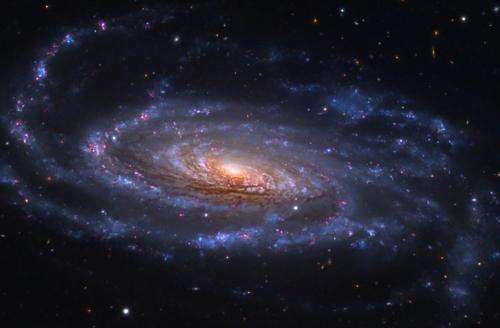High-speed jets from a possible new class of galaxy

Seyfert galaxies are similar to spiral galaxies except that they have extraordinarily prominent, bright nuclei, sometimes as luminous as 100 billion Suns. Their huge energies are thought to be generated as matter falls towards a central supermassive black hole and accretes onto a circumnuclear disk around it. Observations distinguish between two types of Seyferts: those whose nuclear emission appears to be slightly obscured, thought to be the result of viewing the galaxy edge-on through an obscuring disk, and those seen face-on.
Bipolar jets of charged particles moving at relativistic speeds are the most powerful manifestation of the energy release by supermassive black holes. In about 15 per cent of objects, the accretion disc is at the base of a bipolar outflow of such a relativistic plasma. The jets can extend well beyond the host galaxy, producing spectacular lobes of plasma most prominently detected at radio wavelengths but detectable across the entire electromagnetic spectrum. In those cases where the galaxy is seen face-on, and the jet axis is closely aligned with our line of sight, relativistic effects make the jet radiation exceptionally intense and dramatic, with extremely high energy X-ray and gamma-ray light. Since strong radio galaxies are typically seen edge-on (or at somewhat larger angles with the full extent of the outflow observed on the sky), only a small fraction of radio galaxies are observed to have high energy gamma rays.
In 2008, the Fermi satellite discovered high energy gamma ray emission coming from a radio-bright, edge-on Seyfert, PMNJ0948+0022, suggesting the presence of a possible new class of supermassive black hole nucleus. Since then four other examples have been found. CfA astronomers Wystan Benbow, Matteo Cerruti, Pascal Fortin, and Emmet Roache joined a with large team of collaborators to study PMNJ0948+0022 in gamma rays using CfA's VERITAS telescope and at X-ray to optical wavelengths with a compliment of other telescopes. During an observing period about two years ago this month, the source erupted in a bright flare in the optical, ultraviolet, and X-ray wavelengths. VERITAS observed the source about one week later but was unable to detect it. By combining the various results and limits, the team is able to model the emission as arising from charged particles moving at nearly the speed of light (only one part in ten million less) in the presence of magnetic fields about four times as strong as the Earth's field, from the vicinity of a black hole whose mass is about 150 million solar-masses. Although the results are dramatic, further observations are now needed to confirm if this galaxy represents a new class of objects.
More information: "The Most Powerful Flaring Activity from the NLSy1 PMN J0948+0022," F. D'Ammando et al., MNRAS 446, 2456, 2015.
Provided by Harvard-Smithsonian Center for Astrophysics




















